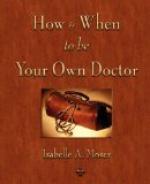When traveling to far away places, exposed to a whole new batch of organisms, frequently having difficulty finding healthy foods, going through time zones, losing nights of sleep, it is easy to become enervated enough to catch a local cold or flu. If I have brought lots of extra vitamin C with me I know that my immune system will be able to conquer just about anything—as long as I also stop eating and can take an enema. I also like to have vitamin C as a part of my first aid kit because if I experience a laceration, a sprain, broken bone, or a burn, I can increase my internal intake as well as apply it liberally directly on the damaged skin surface. Vitamin C can be put directly in the eye in a dilute solution with distilled water for infections and injuries, in the ear for ear infections, and in the nose for sinus infections. If you are using the acid form of C (ascorbic acid) and it smarts too much, make a more dilute solution, or switch to the alkaline form of C (calcium ascorbate) which can be used as a much more concentrated solution without a stinging sensation. Applied directly on the skin C in solution makes a very effective substitute for sun screen. It doesn’t filter out ultraviolet, it beefs up the skin to better deal with the insult.
I believe vitamin C can deal with a raging infection such as pneumonia as well or better than antibiotics. But to do that, C is going to have to be administered at the maximum dose the body can process. This is easily discoverable by a ‘bowel tolerance test’ which basically means you keep taking two or three grams of C each hour, (preferably in the powdered, most rapidly assimilable form) until you get a runny stool (the trots). The loose stool happens when there is so much C entering the small intestine that it is not all absorbed, but is instead, passed through to the large intestine. At that point cut back just enough that the stool is only a little loose, not runny. At this dose, your blood stream will be as saturated by vitamin C as you can achieve by oral ingestion.
It can make an important difference which type of vitamin C is taken because many people are unable to tolerate the acid form of C beyond 8 or 10 grams a day, but they can achieve a therapeutic dose without discomfort with the alkaline (buffered) vitamin C products such as calcium ascorbate, sodium ascorbate, or magnesium-potassium ascorbates.
Vitamin C also speeds up the healing of internal tissues and damaged connective tissue. Damaged internal tissues might include stomach ulcers (use the alkaline form of vitamin C only), bladder and kidney infections (acid form usually best), arthritic disorders with damage to joints and connective tissue (alkaline form usually best). Sports injuries heal up a lot faster with a therapeutic dose of vitamin C. As medicine, vitamin C should be taken at the rate of one or two grams every two hours (depending on the severity of the condition), spaced out to avoid unnecessary losses in the urine which happens if it were taken ten grams at a time. If you regularly use the acid form of vitamin C powder, which is the cheapest, be sure to use a straw and dissolve it in water or juice so that the acid does not dissolve the enamel on your teeth over time.




